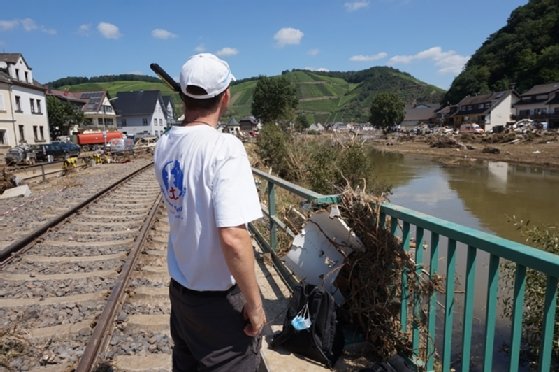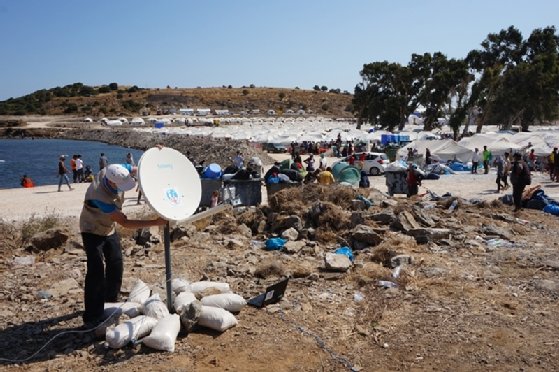
Calling on communications to address humanitarian crises
Télécoms Sans Frontières responds to the growing number of natural disasters with advanced communications and provides protection and assistance, as well as bridging the digital divide
As some sadly know more than others, the world is a much more dangerous place these days. For a variety of reasons, both from politics and through climate change, natural disasters and humanitarian crises are occurring with more regular and alarming frequency than ever – and with seemingly more devastating effects.
And these days when such disasters occur, right at the frontline alongside first-response agencies offering medical and other logistical assistance will often be Télécoms Sans Frontières (TSF).
Almost shadowing the breakthrough evolution of digital mobile technology towards the end of the previous millennium, the organisation was founded in 1998 as the world’s first non-governmental organisation (NGO) focusing on emergency-response technologies. TSF is a member of the United Nations Emergency Telecommunications Cluster (UNETC), a partner of the Office for the Coordination of Humanitarian Affairs (UNOCHA) and the Association of Southeast Asian Nations (ASEAN), and a member of the US State Department’s Advisory Committee on International Communications and Information Policy.
TSF says its mission is based on the principle that, when applied well, technology has the power to save lives. During humanitarian crises, it gives affected people the chance to contact their loved ones and begin to regain control of their lives, as well as build rapid-response communications centres for local and international responders.
It applies and adapts the latest communications technologies to meet emerging needs during humanitarian crises in the areas of disaster response, education, capacity building, protection and assistance – and bridging the digital divide. In parallel with its core activity, it also develops, adapts and makes available what it calls “innovative and cost-effective solutions” to assist migrants, refugees, displaced people and other disadvantaged communities in various areas, including education, healthcare, women’s rights and food security.
‘Ever-evolving humanitarian context’
From its early days, the culture of first emergency response has been core to TSF’s identity, but the organisation has grown and evolved as the role of technologies in emergencies has expanded. It believes that after its two decades of experience in its field, its technical team is able to respond to different crises and beneficiaries’ needs in what it calls “the ever-evolving humanitarian context”.
TSF has two regional offices, one in Thai capital Bangkok to cover Asia-Pacific and a Latin America/Caribbean regional office in Guadalajara, Mexico. To ensure rapid international response and constant global monitoring, each office has the appropriate tools and personnel to deal with emergency response requirements. These resources also make it possible to manage the programmes for which they are responsible and maintain close contact with regional humanitarian representatives.
Representatives in Washington DC and London mirror the vision of TSF in their respective countries and strive to develop new partnerships with leading companies in the global telecoms industry in order to offer effect telecoms solutions in times of crisis. Its current partners include AT&T, Vodafone, Inmarsat, Eutelsat, PCCW Global and Thales, and it is through the corporate telecoms community that TSF sources 75-80% of its funding.
Managing relationships with such providers of the essential telecoms equipment falls under the responsibility of TSF’s head of funding, Rudolf Gordon-Seymour, who describes his role as “having the nice job” and being able to sit in a comfortable chair, in contrast to people out on deployment within 24 hours’ notice, who he regards as the “real heroes of TSF”.

“We’ve got some pretty impressive longstanding partners, and some smaller ones that have come on board over the last 10 years”
Rudolf Gordon-Seymour, TSF
Yet it is fair to say that without funding, such deployment would not happen. Gordon-Seymour recalls the journey the organisation has been on in order to attract the partnerships that make the outfit function. “In the early days, it very much started with looking at satellite providers as partners because that really fitted what we were doing,” he recalls. “Yet with a very heavy reliance on satellite communications, then AT&T came along, because one of the guys had been in marketing there. He introduced TSF to AT&T and they’ve been with us for almost 20 years now.
“So we’ve got some pretty impressive longstanding partners, and then some smaller ones that have come on board over the last 10 years. My background is telecoms – I worked in telecoms for about 20 years. And so I built up a reasonably good network on the telco and tech industry side. So, I try and make introductions and get new funding in place and new partners.”
No two crises the same
No two humanitarian crises are the same and the process for responding to them is therefore different. As Gordon-Seymour puts it, there is no “vanilla deployment”, and the work carried out is the result of a natural or man-made disaster with the only constant of displaced populations and a requirement for those populations to have some basic communications network and also to provide communications network for other NGOs on the ground, so they can coordinate their own operations.
“We sometimes get asked to deploy,” he says. “We’re part of the United Nations emergency cluster. So that’s one part of it and actually the UN may come with a conversation with us and ask us to deploy more often or not. We make our own decision independently to deploy most of the time, and they tend to have to be fairly rapid decisions based on fairly limited information at the time.
“We will normally send a team of two or three out, and they will then get an immediate assessment on the ground, and from there, we will know if we have to then deploy more personnel, more equipment, different types of equipment, depending on what needs have been identified on the ground. As you can imagine, we have a very strong lean towards the engineering side. So, most teams that go out have an engineering background, and they more often than not will be setting up satellite connectivity, and then underlying networks behind that, whether it be data or voice, or both, depending what the immediate need is.”
Just as there are no vanilla deployments, the TSF partners’ engagement is also varied. Most partners are generic funders, so they will give TSF funding on an annual basis for it to use as it sees fit, while others like their funding to go more towards emergency deployment and others are more interested in long-term projects. “We are not limited or restricted in terms of how we can manage that funding,” says Gordon-Seymour.

“Sometimes we may see a partner on the ground, but it is quite rare because the turnaround of deployments is so quick, but there are situations where perhaps one of our partners is present in that region in the world and can help in terms of either volunteers, or if they have some equipment that we could use for that actual mission,” he adds.
“We try to coordinate with partners, but it’s actually pretty difficult because they have to go through some level of pre-training. But my conversations with corporates touch more on employee engagement. And that’s really important to them. A lot of partners don’t just want to be writing a cheque and sending it in the post. They want to be very much more collaborative with the work we do and try to engage their employees at some level.”
What TSF engages with at every level is advanced communications technology. A precise solution can depend on the specific territory that TSF finds itself working in. Gordon-Seymour says technological solutions have shifted over the years from being essentially satellite-based to now accommodating cellular technologies.
“What we’ve seen over the last 20 years is actually a slight shift on what we need to provide from a technical point of view,” he says. “Then we were certainly going out with satellite phones, and we would give people a free three-minute satellite phone call. But now, that’s kind of shifted because actually, the vast majority, even in the developing world, have smartphones or a mobile phone.
Solution has shifted
“So the solution has shifted and we’ve adapted, and we will then create a network for them, which they can connect to with their handset. And we’ve seen that over the last 10 years. I don’t think we’ve probably done anything with 5G networks yet, but certainly work is around 4G networks. We will have equipment that we will create our own kind of GSM network with. And then people can connect to that or we will be looking at voice options as well for the displaced population. But 5G will, of course, happen more and more.”
Because its solutions tend to be unique in some respects, TSF says it is not always easy to introduce new handsets or network hardware on the ground because it is normally always having to adapt for the field. After the port explosion in Beirut, the organisation set up a call centre very quickly using a WhatsApp bot. Although there were 300,000 displaced people, all with different needs, the vast majority of them already had smartphones and the most common application used at that point was the messenger service.
When TSF engineering teams are not out on deployments, they are doing a lot of R&D on the network equipment – it has to be cheap, reliable and small. One of the most common and biggest headaches is power on the ground, especially if TSF finds itself working in the aftermath of an earthquake. There no guarantee that there will be any infrastructure working on the ground, so TSF has to be completely self-sufficient and adapt equipment to work off all kinds of power sources.
Read more about mobile communications
- Air-to-ground network uses commercial 4G LTE, enabling emergency services personnel to rely on uninterrupted communications throughout UK.
- IT giant and leading communications technology provider team to work with South Australian development board and local companies to bring together interdisciplinary experts to develop, test, and deploy new satellite-based comms network.
- Satellite industry is gaining a higher orbit with the non-geostationary market a key engine and recovery to pre-Covid revenues expected in 2022.
Looking at what lessons have been learned in terms of technology over the last three to four years, Gordon-Seymour is clear. “In things like this, it needs to be lighter, it needs to be more portable and needs to be longer-running in terms of battery,” he says. “We’ve seen huge advancements in lithium battery technology and that’s something we can try. We’ve had some logistical issues with batteries on flights, so the power side is very important.”
As is bandwidth – a valuable and sometimes rare commodity in hard-to-reach places. Looking to make the best use of what is at hand, Gordon-Seymour reveals that in addition to the latest technical capabilities on the ground, TSF is looking at the latest technology and services up in the heavens.
“Because we’re dealing with satellites, we’ve got limited bandwidth, and potentially we’ve got latency issues as well,” he says. “On top of that, we have to be quite clever in terms of quality of service-type setups with the equipment. So we use a lot of equipment to maximise the bandwidth, availability and being able to manage both the voice and the data side on the ground, and that’s really important because we are looking at low orbit satellite broadband.
“This could be a real game-changer, but it’s not quite there yet. So we’re still limited to traditional satellite technologies – and uplink and the downlink speeds can vary. We are testing some equipment at the moment. And for us, I think a Starlink type of connection would be a game-changer because I think it could be very cost-effective, but more importantly, it can be deployed very quickly. And it’s much quicker, obviously. We are fairly confident that could be used more and more as Starlink services are rolled out across the world.”
Indeed, TSF is running tests on such services at the moment, but results are not yet available.

Just like for everyone else, the Covid-19 pandemic has made things more difficult for TSF. And just like every other organisation, it has had to adapt to Covid challenges in terms of where it can be. The ultimate aim is to make sure it has the right resources in places where they are needed and that it can respond quickly and decisively. From an equipment point of view, this means trying to find ways to provide better network connectivity for displaced populations.
Gordon-Seymour points to the way forward. “Funding, for us, is very important for the emergency deployments, but also we will continue to expand the long-term programmes that we work on,” he says. “That means migrant support programmes and a lot of education programmes as well. The long-term programmes are very close to our heart – they don’t always get the same level of exposure because the emergency appointments are always very much highlighted in the news, so everyone knows about them.
“The long-term programmes, they are kind of done behind the scenes and there is not too much known about them. Developments in maximising bandwidth and quality of service and connecting smartphones to our network – that’s always going to be important and that’s always evolving.”







